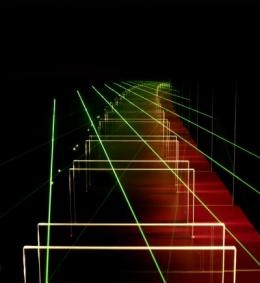Transparent Iron

When one thinks of iron one thinks of a dull grey solid. Transparent iron is an odd thought. The effect of electromagnetically induced transparency (EIT) is a known phenomena from laser physics. With intense laser light of a certain wavelength it is possible to make a non-transparent material transparent for light of another wavelength. This effect is generated by a complex interaction of light with the atomic electron shell. At DESY's X-ray source PETRA III, the Helmholtz research team of Röhlsberger managed to prove for the first time that this transparency effect also exists for X-ray light, when the X-rays are directed towards atomic nuclei of the Mössbauer isotope iron-57 (which makes up 2% of naturally occurring iron). The potential real world benefit for this phenomena may be in the a quantum effects computer which would be extremely fast.
Quantum computers are largely theoretical devices that would exploit the weird properties of matter at extremely small scales to perform calculations, in some cases much more rapidly than conventional computers can.
How did the transparent iron experiment work? The scientists positioned two thin layers of iron-57 atoms in an optical cavity, an arrangement of two parallel platinum mirrors that reflect X-ray light multiple times. The two layers of iron-57 atoms, each approximately three nanometres thick, are precisely kept in position between the two platinum mirrors by carbon, which is transparent for X-ray light of the wavelength used. This kind of sandwich with a total thickness of only 50 nanometres is irradiated under very shallow angles with an extremely thin X-ray beam from the PETRA III synchrotron light source.
Within this mirror system, the light is reflected back and forth several times, generating a standing wave, a so-called resonance. When the light wavelength and the distance between both iron layers are just right in proportion, the scientists can see that the iron becomes almost transparent for the X-ray light. In order for this effect to occur, one iron layer must be located exactly in the minimum (node) of the light resonance, the other one exactly in the maximum. When the layers are shifted within the cavity, the system immediately becomes non-transparent. The scientists attribute this observation to a quantum-optical effect, caused by the interaction of atoms in the iron layers.
"Our result of achieving transparency of atomic nuclei is virtually the EIT effect in the atomic nucleus," Röhlsberger describes the experiments. "Undoubtedly, there is still a long way to go until the first quantum light computer becomes reality. However, with this effect, we are able to perform a completely new class of quantum-optical experiments of highest sensitivity. With the European XFEL X-ray laser, currently being built in Hamburg, there is a real chance to control X-ray light with X-ray light."
This experiment definitely means considerable technical progress for quantum computing: apart from the basic possibility to make almost any materials transparent with light, the intensity of light is decisive for a future technical realisation as well. Every additional quantum of light produces additional waste heat; this would be reduced by the use of the presently discovered effect.
The experiments of the DESY scientists also showed another parallel to the EIT effect: the light trapped in the optical cavity only travels with the speed of a few metres per second — normally it is nearly 300 000 kilometres per second. With further experiments, the scientists will clarify how slow the light really becomes under these circumstances, and whether it is possible to use this effect scientifically. A possible application and at the same time an important building block on the way to light-quantum computers is, for example, the storage of information with extremely slow or even stopped light pulses.
For further information: http://www.physorg.com/news/2012-02-transparent-iron-atomic-nuclei.html or http://www.nature.com/nature/journal/v482/n7384/full/nature10741.html
Photo: Dr. Ralf Roehlsberger, DESY
©2012. Copyright Environmental News Network To subscribe or visit go to: http://www.enn.com